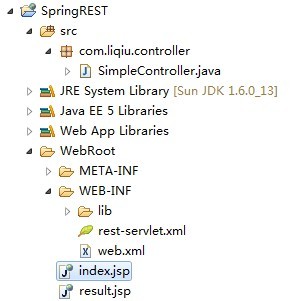Spring3.0实现REST实例
2014-02-25 23:41
337 查看
Spring3.0实现REST实例
2011-06-21 21:5214521人阅读 评论(19)
收藏
举报
springrestxmlhttprequestservletstringencoding
关于REST是什么东西,在这里我就不再多说,大家可以去http://blog.csdn.net/pilou5400/archive/2010/12/24/6096861.aspx看看介绍,直接切入主题:

这是一个rest风格的访问,Spring从3.0开始将全面支持rest。不得不感叹Spring的强悍。
项目结构:

第一步永远是配置,使用框架永远都是先有配置,在web.xml中的配置:
[xhtml]
view plaincopy
<?xml version="1.0" encoding="UTF-8"?>
<web-app version="3.0"
xmlns="http://java.sun.com/xml/ns/javaee"
xmlns:xsi="http://www.w3.org/2001/XMLSchema-instance"
xsi:schemaLocation="http://java.sun.com/xml/ns/javaee http://java.sun.com/xml/ns/javaee/web-app_3_0.xsd"> <display-name></display-name>
<context-param>
<!--rest配置文件的路径,貌似不配置也是加载这个地址,这个地方有点疑问,大家指点指点-->
<param-name>contextConfigLocation</param-name>
<param-value>/WEB-INF/rest-servlet.xml</param-value>
</context-param>
<listener>
<listener-class>org.springframework.web.context.ContextLoaderListener</listener-class>
</listener>
<servlet>
<!-- 配置一个Servlet,有这个Servlet统一调度页面的请求 -->
<servlet-name>rest</servlet-name>
<servlet-class>org.springframework.web.servlet.DispatcherServlet</servlet-class>
<load-on-startup>2</load-on-startup>
</servlet>
<servlet-mapping>
<!-- 映射路径,不要写成了/*那样会拦截所有的访问,连JSP页面都访问不了 -->
<servlet-name>rest</servlet-name>
<url-pattern>/</url-pattern>
</servlet-mapping>
<welcome-file-list>
<welcome-file>/index.jsp</welcome-file>
</welcome-file-list>
</web-app>
第二步:配置rest-servlet.xml这个文件
[xhtml]
view plaincopy
<?xml version="1.0" encoding="UTF-8"?>
<beans xmlns="http://www.springframework.org/schema/beans"
xmlns:xsi="http://www.w3.org/2001/XMLSchema-instance" xmlns:jee="http://www.springframework.org/schema/jee"
xmlns:tx="http://www.springframework.org/schema/tx" xmlns:context="http://www.springframework.org/schema/context"
xmlns:aop="http://www.springframework.org/schema/aop"
xsi:schemaLocation="http://www.springframework.org/schema/beans http://www.springframework.org/schema/beans/spring-beans-2.5.xsd http://www.springframework.org/schema/tx http://www.springframework.org/schema/tx/spring-tx-2.5.xsd http://www.springframework.org/schema/jee http://www.springframework.org/schema/jee/spring-jee-2.5.xsd http://www.springframework.org/schema/aop http://www.springframework.org/schema/aop/spring-aop-2.5.xsd http://www.springframework.org/schema/context http://www.springframework.org/schema/context/spring-context-2.5.xsd" default-lazy-init="true">
<description>Spring公共配置</description>
<!--检测注解-->
<context:component-scan base-package="com.liqiu" />
<bean class="org.springframework.web.servlet.mvc.annotation.DefaultAnnotationHandlerMapping" />
<bean class="org.springframework.web.servlet.mvc.annotation.AnnotationMethodHandlerAdapter" />
<!-- 注册视图解析器,说白了就是根据返回值指定到某个页面 -->
<bean id="viewResolver" class="org.springframework.web.servlet.view.InternalResourceViewResolver">
<property name="viewClass" value="org.springframework.web.servlet.view.JstlView" />
<property name="prefix" value="/"></property> <!--页面文件的路径,在根目录下-->
</bean>
</beans>
第三步:具体实现类
[java]
view plaincopy
package com.liqiu.controller;
import java.io.IOException;
import javax.servlet.http.HttpServletRequest;
import javax.servlet.http.HttpServletResponse;
import org.springframework.stereotype.Controller;
import org.springframework.web.bind.annotation.PathVariable;
import org.springframework.web.bind.annotation.RequestMapping;
import org.springframework.web.bind.annotation.RequestMethod;
@Controller
@RequestMapping("/simple")
public class SimpleController {
//映射路径/simple/index当访问这个路径时,执行这个方法
@RequestMapping("/index")
public String index(HttpServletRequest request ,HttpServletResponse response){
//response,request会自动传进来
request.setAttribute("message", "Hello,This is a example of Spring3 RESTful!");
return "index.jsp";
}
//根据ID获取不同的内容,通过@PathVariable 获得属性
@RequestMapping(value="/{id}",method=RequestMethod.GET)
public String get(@PathVariable String id,HttpServletRequest request ,HttpServletResponse response) throws IOException{
request.setAttribute("message", "Hello,This is a example of Spring3 RESTful!<br/>ID:"+id+"");
//response.getWriter().write("You put id is : "+id);
return "index.jsp";
//return null;
}
}
index.jsp页面:
[xhtml]
view plaincopy
<%@ page language="java" pageEncoding="UTF-8"%>
<html>
<head>
<title>Spring3 RESTful</title>
</head>
<body>
${message}
</body>
</html>
在浏览器中输入:http://localhost:8080/SpringREST/simple/index/,就可以看到效果。
也可以在页面输入不同的参数,获得不同的内容,输入地址:http://localhost:8080/SpringREST/simple/88888,这次执行的就是get方法,通过注解获取ID值,效果:

关于Spring rest 对于Ajax的支持,其实响应Ajax就是通过response返回一个字符串到页面,既然能获得response对象,那问题就迎刃而解了,我们改造下get方法:
[java]
view plaincopy
@RequestMapping(value="/{id}",method=RequestMethod.GET)
public String get(@PathVariable String id,HttpServletRequest request ,HttpServletResponse response) throws IOException{
//request.setAttribute("message", "Hello,This is a example of Spring3 RESTful!<br/>ID:"+id+"");
response.getWriter().write("You put id is : "+id);
//return "index.jsp";
return null;
}
改造index.jsp页面:
[xhtml]
view plaincopy
<%@ page language="java" pageEncoding="UTF-8"%>
<html>
<head>
<title>Spring3 RESTful</title>
<SCRIPT TYPE="text/javascript">
function go(value){
var url = "/SpringREST/simple/"+value+"/";
var request = new XMLHttpRequest();
request.open("GET", url, true);
request.setRequestHeader("Content-Type","application/x-javascript;");
request.onreadystatechange = function() {
if (request.readyState == 4) {
if (request.status == 200){
if (request.responseText) {
document.getElementById("text").innerHTML = request.responseText;
}
}
}
};
request.send(null);
}
</SCRIPT>
</head>
<body>
${message}
<br>
Input the id of you will access object:<input id="id" type="text" size="7"><input type="button" value="Go" onclick="go(document.getElementById('id').value)">
<div id="text"></div>
</body>
</html>
访问http://localhost:8080/SpringREST/simple/index/,在页面里的输入框中输入值,可以看到返回的数据:

DEMO下载:http://download.csdn.net/source/3383568
相关文章推荐
- HDU 1166 敌兵布阵 && HDU 1754 I Hate It(JAVA版)
- JAVA学习笔记——第五章 字符串
- 关于spring framework最新发布压缩包的下载问题 【非常非常新手帖】
- win7下安装JDK并且配置环境变量
- JAVA学习笔记——第四章 流程控制
- Java实现Map集合二级联动
- JAVA学习笔记——第三章 Java语言基础
- Java内存查看与分析
- HDU-2031-进制转换
- java学习记录(七)内存回收机制
- JAVA学习笔记——第一章 初始JAVA
- EASY_PAT_1065 用Java的BigInteger类解决大数问题
- JAVA学习笔记——第二章 Eclipse的下载安装以及配置和启动
- Java 异常处理的原则是什么
- 第一个JAVA程序
- java四舍五入保留两位小数方法整理
- 【Java核心技术——对象克隆】
- java学习第六天
- JavaBean的使用
- 【原创】关于java中的lock
